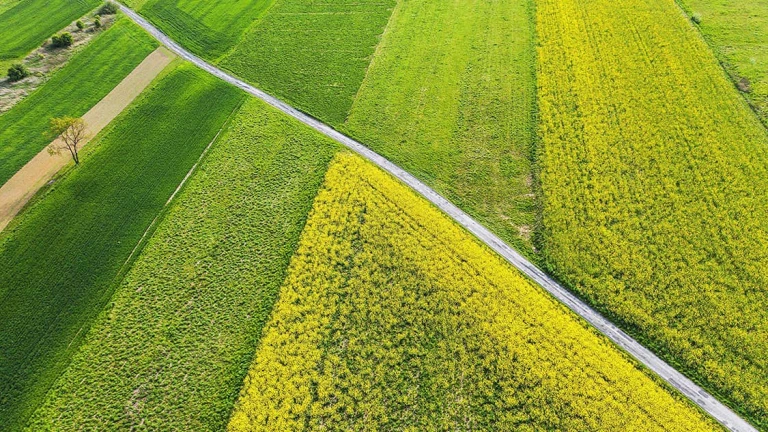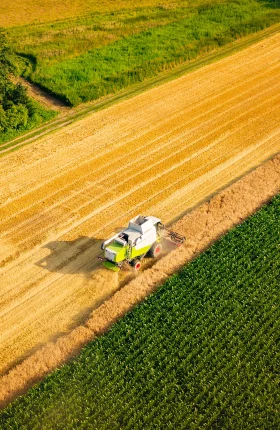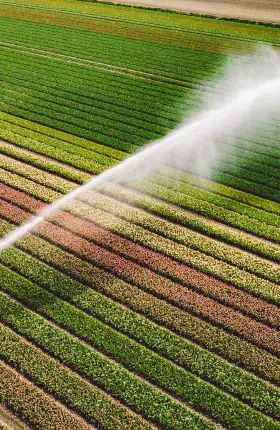You’re either part of the solution or you’re part of the problem, according to the adage attributed to 1960s counterculture activist Eldridge Cleaver. As the adverse impacts of modern agricultural practices become increasingly apparent, big companies that depend on the supply of agricultural products are working to be part of the solution.
Major processors of agricultural feedstock—such as Unilever, Danone, and L’Oréal—have taken decisive initial steps to restore biodiversity in agricultural supply chains. Priorities include fostering regenerative practices, reviving high-value ecosystems, and increasing the diversity of raw materials in their product portfolios. What’s more, major companies are now coordinating their efforts. This is good news. The Stockholm Resilience framework of nine planetary boundaries that regulate the stability and resilience of the Earth’s ecosystem shows that the world silently crossed the biodiversity limit 20 years ago. We are living on borrowed time: we have been operating outside the safe space for humanity to continue to develop without generating large-scale, abrupt, or irreversible environmental changes.
The actions of corporations move us in the right direction, but there is plenty of room to accelerate progress.
The actions of corporations are important steps that move us in the right direction. Still, there is plenty of room to accelerate progress—and to find solutions that can make a difference in both the near term and the long term.
Biodiversity, Once the Norm, Becomes an Imperative
Over decades, the quest for high yield, efficiency, and consistency in agriculture has led to the current reliance on a global standardization of commodities at the expense of sustainability and resilience. Agriculture has become a big contributor to undermining global biodiversity and degrading the environment. This has implications for human health and safety (sustainable agriculture is key to ensuring food safety in some areas) as well as for national security and diplomacy. Climate change creates additional pressure on agricultural value chains, for example, by making it impossible to continue growing the same crops in the same locations.
The current agricultural system is driving biodiversity loss at three levels:
- Species and genetic erosion due to the prevalence of monocultures and intensive farming practices
- Habitat loss as a result of agricultural land expansion and pollution
- The degradation of ecosystem services—such as carbon sequestration, pollination, water supply, erosion control, and pest control—because of unsustainable agriculture practices
Consider the following: Just nine crops make up two-thirds of global agricultural production. Only 30 plants and animals provide 95% of human beings’ caloric intake. Agriculture is responsible for 80% of worldwide deforestation, and almost half of emerging infectious-disease outbreaks in the past 75 years have been related to land-use change. According to the International Union for Conservation of Nature, 30% of agricultural land worldwide is degraded. The Intergovernmental Science-Policy Platform on Biodiversity and Ecosystem Services estimates that 80% of freshwater resources are devoted to crop and livestock production.
Business and Environmental Risks
For companies dependent on agriculture, the loss of biodiversity threatens operations and innovation opportunities. It also poses significant investor, reputation, and regulatory risks.
Operational Risk. The current agriculture system drives biodiversity loss and puts pressure on production resilience in the midterm and long term. Companies risk losing profitability due to the diminishing yields and increasing dependency on expensive agricultural supplements that come from soil depletion and water scarcity. Companies are also exposed to high volatility in the volumes and prices of the key commodities they source, forcing them to rethink their planning strategies and reinvent their supply chain structures to build resilience and protect their supplier bases. Indeed, the lack of variety in the field, which increases crops’ vulnerability to diseases and pests, and the risk of increased extreme-weather events are major sources of uncertainty and volatility in supply chains.
For example, the production of fresh citrus in Florida, a $9 billion industry, has fallen by a total of 75% to 85% in the past 14 years and is considered to be on pace to disappear entirely in the next 10 to 15 years because of disease (particularly huanglongbing, more commonly known as citrus greening). Almond production in California, a $7 billion industry that accounts for more than 70% of global production, is also at risk. More than 35% of US bee colonies, upon which the industry depends, have disappeared each year for the past five years—the combined result of pesticides, habitat loss, disease, and climate change. Coffee production in the six countries that produce the most—and that account for more than 55% of the global coffee-growing area—is threatened by severe erosion rates. Climate change is worsening this erosion and putting at risk a worldwide retail industry worth $80 billion.
Biodiversity loss also undermines opportunities for product development and innovation with natural ingredients that provide flavor, aroma, nutrition, or medicinal attributes, making it more difficult for companies to capture the growing demand for such ingredients. For example, more than one-third of female consumers are willing to pay more for beauty products with natural ingredients, according to a 2019 survey in the US by Mintel.
Investor, Reputation, and Regulatory Risks. Companies that don’t promote biodiversity in their supply chains could see investors lose long-term confidence and pull away to favor more sustainable investments. For example, in May 2020, 30 major European investors representing some €6 trillion in assets under management publicly called for creating a biodiversity impact measurement framework that, among other things, would include the ability to assess negative as well as positive physical impacts on biodiversity.
Companies also face reputation risks that could lead to falling demand or boycotts by consumer activists punishing brands for their environmental track record. Nongovernmental organizations (NGOs) and consumers are increasingly demanding that companies raise their standards and become more accountable with respect to their impact on nature. A recent BCG survey of more than 3,000 people in eight countries found that in the wake of the COVID-19 pandemic, people are more concerned—not less—about addressing environmental challenges and are more committed to changing their own behavior to advance sustainability. Some 70% of survey participants reported that they were more aware now than before COVID-19 that human activity threatens the climate and that degradation of the environment, in turn, threatens humans. And three-quarters of respondents said environmental issues are as concerning as—or more concerning than—health issues.
Companies also risk losing their licenses to operate because, absent company action, stricter regulatory requirements related to biodiversity can be expected to lead to trade and operations disruptions. For instance, biodiversity is already at the top of the environmental political agenda, with several key events—such as the 15th meeting of the Conference of the Parties to the Convention on Biological Diversity—scheduled to take place in 2021 as well as the May 2020 publication of the EU Farm to Fork Strategy and the EU Biodiversity Strategy for 2030. The latter calls for planning legislative measures to avoid or minimize the sale in the EU of products linked to deforestation, posing a clear threat to companies that will need to reinvent their sourcing and portfolios to be able to continue selling in that market.
A Call for Change
Even as more large companies take action, many others have yet to develop the ability to analyze risk exposure and begin shaping solutions for the future. Companies relying on agriculture need to take action in five key areas.
Regenerative agricultural practices enhance biodiversity, improve the resilience of crops, reduce the need for synthetic chemical additives, and increase the capacity of soils to hold water.
The first, and most transformative, is fostering regenerative agriculture practices that help people work with nature and the climate for mutual benefit. These practices leverage the power of plants and agriculture to sequester carbon in the soil and enhance biodiversity in and around the production field. They also improve the resilience of crops while reducing the need for synthetic chemical additives and increase the capacity of soils to hold water and support farmers’ livelihoods. Unilever, for example, committed in June 2020 to launching a new regenerative agriculture code for all of its suppliers. Danone has committed to sourcing 100% of ingredients produced in France from regenerative agriculture by 2025.
Second, companies should deploy restoration initiatives. In May 2020, L’Oréal created the €50 million L’Oréal Fund for Nature Regeneration to restore degraded forest and marine ecosystems, with the goals of restoring 1 million hectares, capturing 15 million to 20 million tons of CO2, and creating hundreds of jobs. Unilever has committed to investing €1 billion in a new dedicated Climate & Nature Fund, which the company will use to pursue projects on landscape restoration, reforestation, carbon sequestration, wildlife protection, and water preservation.
Third, companies should expand the diversity of ingredients and raw materials in their product portfolios to advance both cultivated and consumed biodiversity. For example, companies can leverage the growing demand for local ingredients, which COVID-19 might accelerate, to make a positive impact on biodiversity by sourcing from a broader base of local species or genetic varieties. We also know that certain crops (such as sorghum, rye, buckwheat, and sunflower) and agricultural practices (intercropping and cover cropping) can help address biodiversity loss.
The fourth area of action goes beyond these individual initiatives and involves setting up and backing action-oriented collaborations to protect and restore biodiversity in agriculture. One example is One Planet Business for Biodiversity (OP2B, with which BCG is working as a knowledge partner) which was launched at the United Nations General Assembly in September 2019 and now counts over 20 international cross-sector members. It focuses on the three types of action mentioned at the outset: regenerative agriculture, high-value ecosystems, and product portfolio diversification.
Finally, companies and coalitions can help the industry engage in a transparent dialogue around nature and biodiversity with consumers. There are already plenty of “label fads” in food and consumer products—“free trade,” “free-range,” and “non-GMO” are a few examples—but some of these have more teeth and a stronger bite than others. Consumer companies can lead by putting their efforts behind the most robust initiatives, even if they tend to be more difficult and often require third-party verifiable traceability that goes beyond an honor code or self-reporting.
These five areas of action seek to advance a full transition to biodiverse value chains through substantive changes in how companies operate. We consider five key enablers critical to making this happen.
Integrate biodiversity as a driver of resilience and value creation. Biodiversity should be fully integrated into a company’s business with metrics that become part of strategic planning and budgeting decision making. Top decision makers need to factor biodiversity concerns into their decisions with an understanding of whether and how their action will impact the business. Biodiversity goals should be reflected in a robust but simple set of metrics that seek to improve supply chain traceability and measure and evaluate the impact of the company’s actions on the ground. These metrics must be scientifically sound and aligned with those used by the financial community. Biodiversity actions can also support other sustainability priorities. For example, regenerative agriculture projects can contribute to carbon footprint reduction targets.
Strengthen collaboration with key stakeholders. Companies need to work with their suppliers and partners to build nature-based agricultural solutions that coordinate with broader science-based targets, such as alignment on a regenerative agriculture taxonomy of practices. They need to play a leading role in working with farmers to adopt regenerative and biodiverse agricultural practices for the long term. Governmental institutions have a regulatory role to play in setting an environment that will accelerate the transition of the agricultural system (a carbon market for farmers, for example, or subsidies redirections). Companies can help shape these initiatives. Along with peers and others across the value chain, they can work together to reshape the playing field for all competitors and reduce individual risk.
Build relevant funding solutions with public and private financial institutions. The transition to a biodiverse future will be expensive, and farmers are at the highest risk. (Some estimates put the cost of converting the 5 billion hectares of farmed land worldwide to regenerative agriculture at $2 trillion to $3 trillion.) To help ensure farmers’ livelihoods, companies can work with funding sources in the public and private sectors to develop solutions that distribute the costs and risks across multiple parties and make the transition practicable from a financial point of view.
Companies can work with funding sources in the public and private sectors to develop solutions that distribute the costs and risks across multiple parties.
Raise awareness and demystify biodiversity for consumers. Companies’ own marketing and public outreach efforts can significantly advance consumer education and the awareness of biodiversity as a critical issue of global sustainability.
Raise the transparency. The industry needs to invest in gathering and presenting data to increase the transparency of its biodiversity efforts. Consumers find information about sustainability to be challenging and confusing. They want more information about products and their provenance through the supply chain—and providing this type of data will increasingly be critical to building awareness and trust. A big constraint is the fragmentation of data as well as the lack of platforms that collect data and make it available for communication and other uses. This absence makes presenting a unified view challenging. For companies to be able to engage consumers, the industry needs to work with suppliers and regulators and make progress together. Companies can start by investing in data and platforms that can provide a common and trustworthy basis for understanding the impact of actions taken through the supply chain.
The COVID-19 crisis serves as a vital reminder of what can happen when we ignore or fail to effectively address existential threats. Given the current lack of resilience in agricultural value chains and the increasing global momentum around biodiversity among consumers, NGOs, governments, and investors, companies relying on agriculture in their supply chains should act now. They have the opportunity to innovate and build back better.
The authors are grateful to Malak Mahmoun and Silvia Mata for their assistance with this article.






